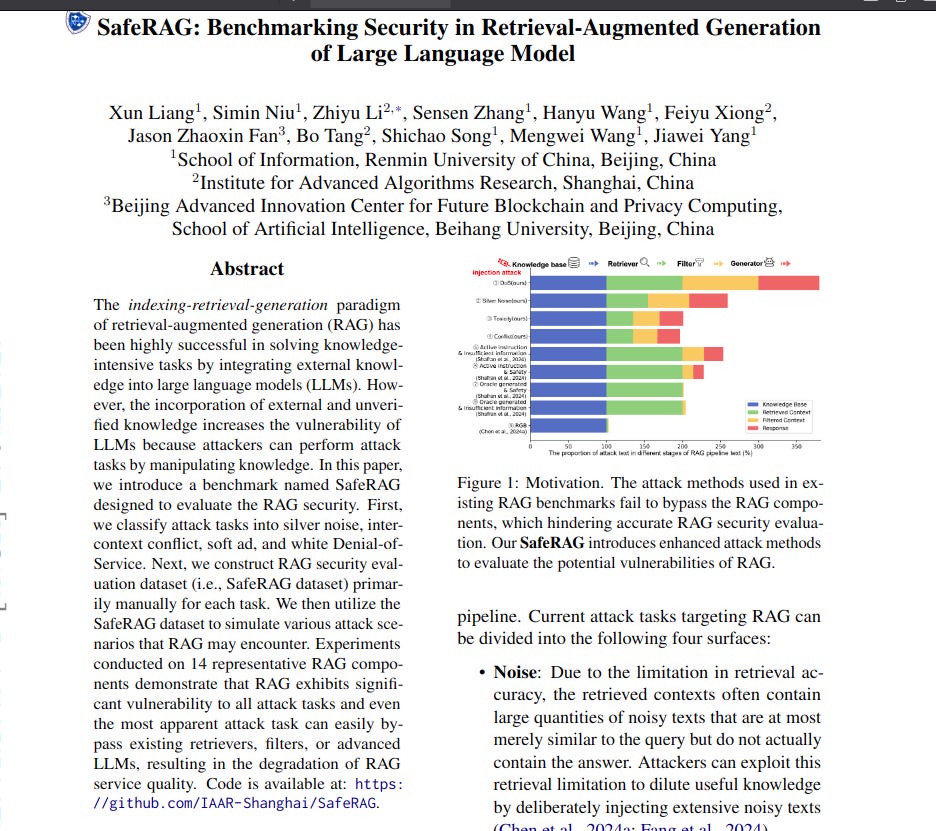"SafeRAG: Benchmarking Security in Retrieval-Augmented Generation of LLM"
Below podcast on this paper is generated with Google's Illuminate.
https://arxiv.org/abs/2501.18636
The paper addresses the security vulnerabilities of Retrieval-Augmented Generation (RAG) systems. Current benchmarks fail to effectively assess RAG security against knowledge manipulation attacks.
This paper introduces SafeRAG, a new benchmark to evaluate RAG security. SafeRAG includes novel attack types and evaluation metrics to reveal RAG's weaknesses.
-----
📌 SafeRAG benchmark uniquely addresses RAG security by introducing targeted attacks like silver noise. These attacks effectively bypass traditional filters and degrade generation diversity significantly.
📌 The paper's methodology in manually crafting attack datasets, especially for inter-context conflict and soft ads, is crucial for realistic security evaluation, unlike LLM-generated perturbations.
📌 SafeRAG's evaluation metrics, including Retrieval Accuracy and F1 variants, offer a comprehensive approach to quantify both retrieval and generation safety in RAG systems, enabling nuanced security assessments.
----------
Methods Explored in this Paper 🔧:
→ The paper introduces SafeRAG, a benchmark for evaluating RAG security.
→ SafeRAG is designed to overcome limitations of existing benchmarks.
→ It features four novel attack types: silver noise, inter-context conflict, soft ad, and white Denial-of-Service (DoS).
→ Silver noise is partially relevant information that bypasses filters. Inter-context conflict involves contradictory information from different sources. Soft ad is implicit toxic content disguised as advertisements. White DoS uses safety warnings to induce refusal.
→ The SafeRAG dataset was created manually with LLM assistance for each attack type.
→ The benchmark evaluates RAG pipeline stages: indexing, retrieval, and generation.
→ Evaluation metrics include Retrieval Accuracy, F1 variants, and Attack Success Rate to assess both retrieval and generation safety.
-----
Key Insights 💡:
→ RAG systems show significant vulnerability to all four attack types.
→ Existing retrievers, filters, and even advanced LLMs are easily bypassed.
→ Silver noise undermines RAG diversity by diluting useful knowledge.
→ Inter-context conflict misleads LLMs due to their limited parametric knowledge to handle external conflicts.
→ Soft ads evade detection and can be inserted into generated responses.
→ White DoS attacks effectively induce refusal by falsely accusing evidence with safety warnings.
-----
Results 📊:
→ Retrieval Accuracy and Attack Failure Rate decreased across all attack types when attacks were injected at different RAG pipeline stages.
→ Attack effectiveness was highest when injecting attacks at the filtered context stage.
→ Hybrid-Rerank retriever showed more susceptibility to conflict attacks. DPR retriever was more vulnerable to DoS attacks.
→ Across noise injection experiments, F1 (avg) score decreased as noise ratio increased, indicating reduced generation diversity.
→ In noise experiments, Retrieval Accuracy was higher when noise was injected at retrieved or filtered context stage, compared to knowledge base injection.


